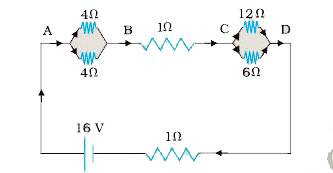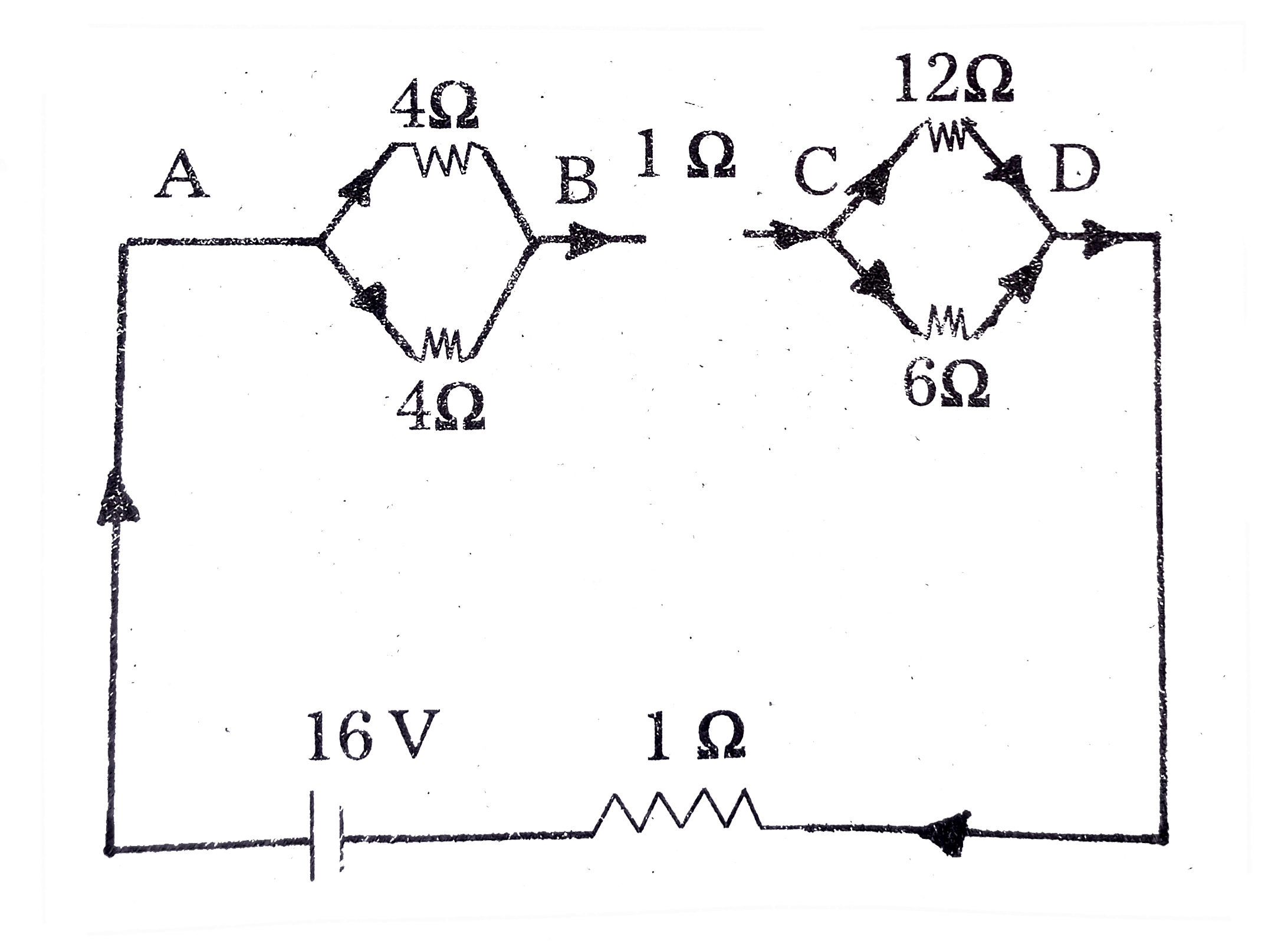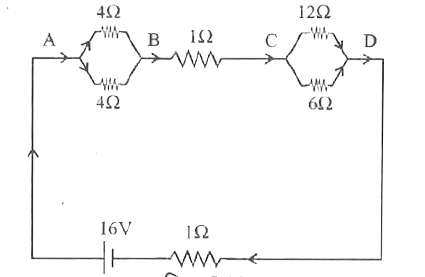A network of resistore is connected to a 16 V battery with internal resistance of 1Ω, as shown in (a) Compute the equivalent resistance of the network. (b) Obtain the current in each resistor. (c ) obtain the voltage drops VAB,VBCandVCD
 Solution in Gujrati
Solution in Gujrati
(a) The network is a simple series and parallel combination of resistors. First the two 4Ω resistors in parallel are equivalent to a resistor =[(4×4)/(4+4)Ome>a=2α
In the same way. The 12Ωand6Ω resistores in parallel are equivalent ot a resistor of
[(12×6)/(12+6)]Ω=4Ω
The equivalent resistance R of the networn is obtained by conmbining these resistore (2Ωand4Ω) with 1Ω in series. that is.
R=2Ω+4Ω+1Ω=7Ω
(b) The total current In in the circuit is
I=∈R+r=16v(7+1)Ω=2A
Consider the restors between A and B. If I1 is the current in one of the 4Ω resistors and I(2) the current in the other.
I1×4=I2×4
then is, I1=I2, which is otherwise obvious from the symmetry of the two arma. But I1+I2=I=2A. Thus.
I1=I2=1A
that , is current in each 4Ω resistor is 1A. Current in 1Ω resistor between B and C would be 2 A.
Now, consider the resistance between C and D. If I3 is the current in the 12Ω resistor, and I4 in the 6Ω rsistor.
I3×12=I4×6,i.e.,I4=2I3
But, I3+I4=I=2A
Thus, I3=(23)A,I4=(43)A
that is, the current in the 12Ω resistor is (2/3) A, whithe the current in the 6Ω resistor is (4/3) is
VAB=IA×4=1A×4Ω=4V.
This can also be obtained by multtplying the total current between A and B by the equivalent resistance between A and B, that is.
VAB=2A×2Ω=4V
The voltage drop across BC is
VBC=2A×1Ω=2V
Finally, the voltage drop across CD is
VCD=12Ω×I3=12Ω×(23)A=8V.
This can alternately be obtained by multiplying total current between C and D by the equivalent resistance between C and D. that is
VCD=2A×4Ω=8V
Note that the total voltage drop across AD is 4V+2V+8V=14V. Thus, the terminal voltage of the bettery is 14 V, while its emf is 16 V. The loss of the voltege (=2V) is accounted for by the internal resistance 1Ω of the bettery [2A×1Ω=2V].
Topper's Solved these Questions
- CURRENT ELECTRICITY BOOK - NCERT GUJARATICHAPTER - CURRENT ELECTRICITY EXERCISE - EXERCISES
12 Videos
- CURRENT ELECTRICITY BOOK - NCERT GUJARATICHAPTER - CURRENT ELECTRICITY EXERCISE - ADDITIONAL EXERCISES
9 Videos
- ATOMSBOOK - NCERT GUJARATICHAPTER - ATOMSEXERCISE - ADDITIONAL EXERCISE
10 Videos
- DUAL NATURE OF RADIATION AND MATTERBOOK - NCERT GUJARATICHAPTER - DUAL NATURE OF RADIATION AND MATTEREXERCISE - EXERCISES
41 Videos
Similar Questions
The storage battery of a car has an emf of 12 V. If the internal resistance of the battery is 0.4Ω what is the maximum current that can be drawn from the battery ?
View SolutionThe earth's surface has a negative surface charge density of 10−9Cm−2. The potential difference of 400 kV between the top of the atmosphere and the surface results (due to the low conductivity of the lower atmosphere) in a current of only 1800 A over the entire globe. If there were no mechanism of sustaining atmospheric electric field, how much time (roughly) would be required to neutralise the earth's surface? (This never happens in practice because there is a mechanism to replenish electric charges. namely tghe coontainual thunderstorms and lighting in different parts of the globe). (Radius of earth =6.37×106m.)
View SolutionAnswer the following questions, which help you understand the difference between Thomson’s model and Rutherford’s model better.
(a) Is the average angle of deflection of a-particles by a thin gold foil predicted by Thomson’s model much less, about the same, or much greater than that predicted by Rutherford’s model?
View SolutionFind the
(a) maximum frequency, and
(b) minimum wavelength of X-rays produced by 30 kv electrons.
View SolutionA network of resistances is connected to a 16 V battery with internal resistance of 1Ω as shown in figure. (a) Compute the equivlaent resistance of the network. (b) Obtain the current in each resistor and (c ) obtain the voltage dropVAB,VBC and VCD.

View SolutionA network of resistances is connected to a 16 V battery with internal resistance of 1 Omega , as shown in Fig. 4.33. (a) Compute epuivalent resistance of the network, (b) obtain the current In in each resistor, and (c ) obtain the voltage drops V_(AB), V_(BC) " and " V_(CD) .
View SolutionA network of resistor is connected to a 16 V battery with internal resistance of 1 Omega , a shown in fig. (a) complete the equivalent resistance of the network.
View SolutionA network of resistor is connected to a 16 V battery with internal resistance of 1Ω, a shown in fig.
Obtain the current in each resistor.

View SolutionA network of resistor is connected to a 16 V battery with internal resistance of 1Ω, a shown in fig.
Obtain the voltage drops VAB,VBC and VCD

View Solutionनिम्न चित्र के अनुसार 1Ω आंतरिक प्रतिरोध के 16 V कि एक बैटरी से प्रतिरोधों के एक नेटवर्क को जोड़ा गया है ।
नेटवर्क के तुल्य प्रतिरोध कि गणना कीजिए ।

View Solutionनिम्न चित्र के अनुसार 1Ω आंतरिक प्रतिरोध के 16 V कि एक बैटरी से प्रतिरोधों के एक नेटवर्क को जोड़ा गया है ।
प्रत्येक प्रतिरोधक में धारा का मान ज्ञात कीजिए |

View Solutionचित्र में दर्शाए अनुसार 1Ω आन्तरिक प्रतिरोध की 16V की एक बैटरी से प्रतिरोधों के एक नेटवर्क को जोड़ा गया है।

वोल्टता पात VAB,VBC तथा VCD ज्ञात कीजिये।
View Solutionचित्र में दिखाए गए अनुसार आंतरिक 1Ω प्रतिरोध के की एक बैटरी में प्रतिरोधों के 16 V एक नेटवर्क को जोड़ा गया है
नेटवर्क का तुल्य प्रतिरोध परिकलित कीजिये |
View SolutionA network of resistors is connected to a 5 V battery with internal resistance of 1Omega as shown in Fig. (a) Compute the equivalent resistance of the network. (6) Obtain the current in each resistor. (c) Obtain the voltage drops V_(BC) and V_(CD)
View SolutionA network of resistore is connected to a 16 V battery with internal resistance of 1Omega, as shown in (a) Compute the equivalent resistance of the network. (b) Obtain the current in each resistor. (c ) obtain the voltage drops V _(AB), V _(BC) and V _(CD)
View Solution
